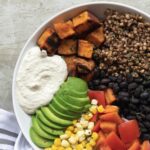Indulge in a world of guilt-free pleasure! Discover the secrets to creating decadent desserts that are completely free of common allergens, yet bursting with rich flavors and textures that will tantalize even the most discerning palate. This guide unveils a collection of recipes designed to satisfy every sweet tooth, regardless of dietary restrictions, showcasing innovative techniques and substitutions that transform everyday baking into an extraordinary culinary experience. Prepare to be amazed by the possibilities!
From fluffy, cloud-like cakes to intensely chocolatey brownies and creamy, dreamy cheesecakes, we explore a range of allergen-free dessert options. Learn how to master gluten-free and dairy-free baking techniques, achieving that perfect rise and melt-in-your-mouth texture without compromising on taste. We’ll delve into creative presentation, transforming simple desserts into visually stunning masterpieces with allergen-free garnishes and decorations. Whether you’re catering to specific dietary needs or simply seeking delicious and innovative dessert options, this guide provides the knowledge and inspiration to create unforgettable treats.
Creative Presentation and Decoration
Transforming allergen-free desserts from delicious to dazzling requires thoughtful presentation and decoration. The right techniques can elevate these treats, making them visually stunning and even more appealing. This section provides detailed steps for decorating five allergen-free desserts, focusing on creating a decadent and memorable experience.
Decorating Allergen-Free Chocolate Avocado Mousse
Step 1: The Base. Pipe or spoon the rich, dark-green avocado mousse into individual serving glasses or small bowls. Ensure a smooth, even layer, leaving a small space at the top for garnish. Use a piping bag fitted with a large round tip for a professional look.
Step 2: Berry Swirl. Gently swirl a vibrant puree of fresh raspberries or strawberries over the mousse. Use a toothpick or a small offset spatula to create a beautiful marbled effect. The bright red contrasts beautifully with the deep green.
Step 3: Chocolate Shavings. Using a vegetable peeler, create delicate chocolate shavings from high-quality allergen-free dark chocolate. Sprinkle these shavings artfully over the berry swirl, adding a touch of elegance and a satisfying crunch.
Step 4: Fresh Mint. A single, perfectly formed fresh mint leaf placed atop the chocolate shavings adds a final touch of freshness and visual appeal. The vibrant green complements the other colors beautifully.
Decorating Allergen-Free Coconut Mango Sorbet
Step 1: Chill Factor. Ensure the sorbet is perfectly chilled before serving. This will maintain its shape and texture.
Step 2: Layered Delight. Layer the vibrant yellow mango sorbet with a thin layer of creamy coconut milk ice cream in elegant dessert glasses. Alternate the layers for a visually striking effect.
Step 3: Tropical Garnish. Garnish with toasted coconut flakes for a subtle crunch and added texture. A few slivers of fresh mango, arranged in a decorative pattern, add a burst of color and juicy sweetness.
Step 4: Edible Flower. A single, delicate edible flower, such as a pansy or a viola, adds a touch of sophistication and vibrant color. Its subtle sweetness complements the sorbet perfectly.
Decorating Allergen-Free Flourless Chocolate Cake
Step 1: Dusting Magic. Once the cake has cooled completely, dust it generously with a fine layer of allergen-free cocoa powder. Use a fine-mesh sieve for an even distribution.
Step 2: Ganache Glaze. Prepare a rich, dark chocolate ganache using allergen-free dark chocolate and coconut cream. Pour it over the cake, allowing it to drip down the sides for a decadent look.
Step 3: Berry Accents. Arrange fresh raspberries and blueberries artfully around the base of the cake, creating a vibrant and colorful border. The juicy berries provide a delightful contrast to the rich chocolate.
Step 4: Chocolate Curls. Use a vegetable peeler to create thin chocolate curls from allergen-free dark chocolate and arrange them on top of the ganache for an elegant and sophisticated touch.
Decorating Allergen-Free Lemon Poppy Seed Cupcakes
Step 1: Lemon Zest. Once the cupcakes have cooled, sprinkle a generous amount of finely grated lemon zest over the tops. The bright yellow zest adds a burst of color and a fragrant citrus aroma.
Step 2: Cream Cheese Frosting. Pipe a swirl of smooth, creamy allergen-free cream cheese frosting onto each cupcake. Use a piping bag with a star tip for a decorative effect.
Step 3: Poppy Seed Sprinkle. Sprinkle a light dusting of poppy seeds over the frosting. The tiny black seeds add a subtle texture and visual interest.
Step 4: Candied Lemon Peel. Place a small piece of candied lemon peel on top of each frosting swirl. The bright yellow and sweet taste add a sophisticated touch.
Decorating Allergen-Free Peach Cobbler
Step 1: Golden Crust. Ensure the cobbler’s crust is golden brown and bubbly. This indicates that it is perfectly baked and has a delightful texture.
Step 2: Peach Perfection. Arrange sliced fresh peaches artfully around the edges of the cobbler, creating a beautiful border of juicy fruit.
Step 3: Vanilla Bean Ice Cream. Serve a scoop of allergen-free vanilla bean ice cream alongside the cobbler. The creamy vanilla complements the sweetness of the peaches and the warm spices of the cobbler.
Step 4: Cinnamon Dust. Lightly dust the cobbler with cinnamon before serving. The warm spice enhances the aroma and adds a touch of rustic charm.
Allergen-Free Dessert Variations and Adaptations

Creating decadent allergen-free desserts requires careful consideration of ingredient substitutions and adaptations to accommodate various dietary needs. This section explores variations of a single dessert recipe, highlighting common allergen substitutes and strategies for customizing recipes to meet individual preferences. We will focus on a rich, chocolate mousse as our base recipe, demonstrating how to transform it into vegan, keto, and low-sugar options.
Chocolate Mousse Variations
This section details three variations of a classic chocolate mousse, each tailored to a specific dietary need: vegan, keto, and low-sugar. Each variation maintains the rich, decadent texture and flavor of the original, proving that deliciousness doesn’t have to compromise health or dietary restrictions.
Vegan Chocolate Mousse
This variation replaces dairy ingredients with plant-based alternatives to create a luxuriously creamy, allergen-free dessert suitable for vegans and those with dairy sensitivities.
Ingredients: 1 can (13.5 oz) full-fat coconut milk, refrigerated overnight; 1 cup high-quality vegan dark chocolate, finely chopped; 1/4 cup unsweetened cocoa powder; 1/4 cup maple syrup (or agave nectar); 1 teaspoon vanilla extract; Pinch of salt.
Instructions: 1. Scoop out the thick, solidified coconut cream from the top of the refrigerated can of coconut milk, leaving the watery liquid behind. 2. Melt the vegan chocolate in a double boiler or microwave in 30-second intervals, stirring until smooth. 3. In a mixing bowl, whisk together the coconut cream, melted chocolate, cocoa powder, maple syrup, vanilla extract, and salt until light and fluffy. 4. Chill for at least 2 hours before serving. The mousse will thicken as it chills, achieving a wonderfully smooth and creamy texture. The deep brown color of the chocolate is beautifully contrasted by the creamy white of the coconut cream. Imagine the rich, dark chocolate flavor mingling with the subtle sweetness of the maple syrup.
Keto Chocolate Mousse
This keto-friendly version utilizes low-carb sweeteners and healthy fats to create a decadent chocolate mousse that aligns with ketogenic dietary guidelines.
Ingredients: 1 cup heavy cream; 1/2 cup unsweetened cocoa powder; 1/4 cup erythritol or other keto-friendly sweetener; 1 teaspoon vanilla extract; 2 tablespoons unsweetened almond butter; Pinch of salt.
Instructions: 1. Whip the heavy cream until stiff peaks form. The whipped cream should be thick and voluminous, resembling soft clouds. 2. In a separate bowl, whisk together the cocoa powder, sweetener, vanilla extract, almond butter, and salt until smooth. 3. Gently fold the cocoa mixture into the whipped cream until just combined. Be careful not to overmix, preserving the airy texture of the whipped cream. 4. Chill for at least 1 hour before serving. The dark, rich cocoa powder perfectly complements the creamy texture of the heavy cream, creating a luscious chocolate experience that fits perfectly within a ketogenic diet.
Low-Sugar Chocolate Mousse
This variation minimizes added sugar while maintaining the rich chocolate flavor, making it suitable for individuals watching their sugar intake.
Ingredients: 1 cup full-fat Greek yogurt; 1/2 cup unsweetened cocoa powder; 1/4 cup stevia or other low-calorie sweetener; 1 teaspoon vanilla extract; 1 tablespoon unsweetened shredded coconut; Pinch of salt.
Instructions: 1. In a mixing bowl, whisk together the Greek yogurt, cocoa powder, sweetener, vanilla extract, shredded coconut, and salt until smooth and creamy. The Greek yogurt provides a naturally tangy element that balances the sweetness and bitterness of the chocolate. 2. Chill for at least 30 minutes before serving. The mousse will thicken slightly as it chills. The addition of shredded coconut adds a pleasant textural contrast to the smooth mousse, enhancing the overall sensory experience.
Common Allergens and Substitutes in Baking
Many common baking ingredients contain allergens such as dairy, gluten, nuts, and eggs. Understanding suitable substitutes is crucial for creating allergen-free desserts.
Dairy can be replaced with plant-based milks (almond, soy, oat), coconut cream, or vegan butter. Gluten-free flours (almond, coconut, rice) are excellent substitutes for wheat flour. Nuts can be substituted with seeds (sunflower, pumpkin, chia) or nut-free butters. Eggs can be replaced with applesauce, mashed banana, flax eggs (flaxseed meal mixed with water), or chia seed eggs.
Adapting Recipes to Dietary Restrictions
Adapting recipes requires careful consideration of ingredient functionality. For example, when substituting flour, consider the moisture-absorbing properties of different gluten-free options. When replacing eggs, ensure the substitute provides similar binding and leavening properties. Always taste-test and adjust sweetness and flavor as needed, ensuring the final product is both delicious and allergen-free.
Recipe and Step-by-Step Creation Guide
This section provides a comprehensive guide for creating a decadent allergen-free chocolate avocado mousse, a rich and surprisingly healthy dessert perfect for those with dietary restrictions or simply seeking a lighter indulgence. The recipe is easily adaptable to various dietary needs and preferences.
Ingredients
This recipe uses simple, readily available ingredients, many of which can be substituted based on dietary needs and preferences. Precise measurements ensure a consistently delicious result.
- 1 ripe avocado, pitted and peeled: The avocado provides creaminess and richness, forming the base of the mousse. Choose a perfectly ripe avocado for optimal texture and flavor. A slightly overripe avocado will result in a smoother, creamier mousse.
- 1/4 cup unsweetened cocoa powder: This provides the deep chocolate flavor. Use a high-quality cocoa powder for the best taste. For a more intense chocolate flavor, consider adding a tablespoon of dark chocolate powder.
- 1/4 cup maple syrup or agave nectar: This provides sweetness and balances the richness of the avocado and cocoa. Adjust the amount to your preferred sweetness level. Honey can also be used as a substitute.
- 1 teaspoon vanilla extract: This enhances the overall flavor profile. Pure vanilla extract is recommended for the most authentic flavor.
- 1/4 cup full-fat coconut milk: This adds creaminess and helps to achieve the desired mousse-like texture. For a richer mousse, use full-fat coconut milk from a can; for a lighter texture, use light coconut milk.
- Pinch of sea salt: This enhances the other flavors and balances the sweetness.
Step-by-Step Creation
This section provides a detailed, step-by-step guide to creating the chocolate avocado mousse. Following these instructions carefully will result in a smooth, decadent dessert.
- Preparing the Avocado: Begin by carefully peeling and pitting the ripe avocado. Imagine the avocado’s smooth, green flesh, revealing itself as you gently remove the skin. The pit should come away cleanly, leaving a perfectly smooth surface. Cut the avocado into chunks. This makes it easier to blend.
- Combining Ingredients: Add the avocado chunks, cocoa powder, maple syrup, vanilla extract, coconut milk, and salt to a high-speed blender. Visualize the ingredients combining in the blender, a swirl of dark brown and vibrant green.
- Blending the Mousse: Blend the mixture until completely smooth and creamy. This will take approximately 1-2 minutes. The mixture should be thick and free of any lumps. The color should be a rich, dark chocolate brown with hints of the avocado’s green subtly visible.
- Chilling the Mousse: Transfer the mousse to individual serving dishes or a larger bowl. Cover and refrigerate for at least 2 hours, or preferably overnight, to allow the flavors to meld and the mousse to set. As it chills, imagine the mousse thickening and taking on a velvety texture.
- Serving the Mousse: Once chilled, the mousse will have a firm yet creamy texture. Garnish as desired with fresh berries, shredded coconut, or a dusting of cocoa powder. Picture the beautiful presentation: a rich, dark brown mousse, topped with bright red berries or a dusting of cocoa powder, creating a visual feast.
Troubleshooting Tips
This section offers solutions to common issues that may arise during the creation of the chocolate avocado mousse.
- Lumpy Mousse: If the mousse is lumpy after blending, continue blending for a longer period, ensuring all ingredients are thoroughly incorporated. Adding a tablespoon or two more of coconut milk can also help achieve a smoother consistency.
- Too Thin Mousse: If the mousse is too thin, chill it for a longer period. The mousse will thicken as it chills. Alternatively, you can add a tablespoon of chia seeds or flax meal to help thicken the mixture before chilling.
- Too Sweet Mousse: If the mousse is too sweet, reduce the amount of maple syrup or agave nectar next time. A touch of lemon juice can also help to balance the sweetness.
Recipe Adaptation
This section details how to adapt the recipe based on available ingredients and equipment.
Ingredient Substitutions: Maple syrup can be substituted with honey or another liquid sweetener. Full-fat coconut milk can be replaced with other plant-based milks, although the texture may vary. For a dairy-free option, ensure all ingredients are dairy-free.
Equipment Adaptations: If you don’t have a high-speed blender, a food processor can be used, although the mousse may not be as smooth. A hand mixer can also be used, but more effort will be required to achieve a smooth consistency.
Unleash your inner pastry chef and embark on a delightful journey of allergen-free baking. This guide has equipped you with the skills and recipes to craft decadent desserts that are not only free from common allergens but also brimming with exquisite flavors and stunning presentations. Remember, indulgence doesn’t have to mean compromise. With a little creativity and the right techniques, you can create sensational treats that everyone will adore, leaving a lasting impression of deliciousness and delight. So, gather your ingredients, and let the baking begin!
Expert Answers
Can I use store-bought allergen-free mixes?
While convenient, store-bought mixes may contain unexpected additives. Always check ingredient labels carefully to ensure they align with your specific dietary needs. Homemade options offer greater control over ingredients and taste.
How long can I store these allergen-free desserts?
Storage times vary depending on the dessert. Generally, cakes and brownies can last 3-5 days in an airtight container at room temperature, while cheesecakes should be refrigerated for optimal freshness. Always check for signs of spoilage before consuming.
What are the best substitutes for eggs in allergen-free baking?
Flax eggs (flaxseed meal mixed with water), applesauce, or mashed banana are popular egg substitutes, each offering slightly different properties. The best choice depends on the specific recipe and desired texture.
Can I freeze allergen-free desserts?
Many allergen-free desserts freeze well. Wrap them tightly in plastic wrap and then foil to prevent freezer burn. Thaw overnight in the refrigerator before serving.


